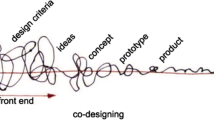Abstract
Smart Mobility is a chance for local ecosystems to foster mobility efforts and make use of methodological basics, techniques, and tools such as the Building Blocks for Intelligent Mobility (BIM) and a field-tested Smart Mobility Procedure Model. How do Smart Mobility initiatives find entry into daily business activities? Which follow-up measures could be derived based on a number of projects and hands-on experience? This asks for a pragmatic optimism! What it is means is the cultivation of a practitioner oriented approach with the assistance of innovation empowerment, creativity, and an interest in a solution that fits all participating parties. It might not be the best-in-class solution that is applicable and deployable, rather the one that allows a participatory construct, offers benefits, and approaches the final goal of Smart Mobility in digestible steps.
Access provided by CONRICYT-eBooks. Download chapter PDF
Similar content being viewed by others
Keywords
These keywords were added by machine and not by the authors. This process is experimental and the keywords may be updated as the learning algorithm improves.
Adding to the presented cases and examples and their assortment along the Smart Mobility Procedure Model and BIM, the following explanations are dedicated to introduce new perspectives, propose practical transformation needs, and recommend follow-up measures.
The discourse on optimal mobility offerings is directly linked with the demand for everybody’s right to mobility. To turn this demand into reality, the following action items are considered:
-
The strategic impact of Smart Mobility offerings on ecosystems is targeted towards the needs of personae and things
-
Deploying seamless mobility through a solution portfolio that is accessible to everyone for door-to-door mobility
-
Making use of modern and innovative information systems and communication technologies to transform critical and effort limiting events into a compelling positive experience throughout a digital sentinel.
The study of influencing factors that lead to an increased usage and acceptance of Smart Mobility offerings is part of any Smart Mobility initiative. Instead of the product “bus taking” or “taxi riding” the service mobility and the mobility business process are being leveraged. Facilitated by adopting the viewpoint of a persona and environmental encountering, the context, Smart Mobility operations depend on the collaborative end in a cross-organizational, mobility-related business processing and monitoring activity. Those “public processes” that are commonly managed amongst service providers and operators are a result of three observations:
-
1.
Mobility driving business processing is increasingly characterized by a greater and more flexible individualization of requirements.
-
2.
Connecting the connectable, meaning interweaving things, information, and needs in a digital manner to derive benefits.
-
3.
The vehicle transforms into another form of habitat, living and work space. Autonomous driving is opening up a whole new set of possibilities and freedom for mobility consumers.
Granting innovation as something good asks not only for a systematic approach, but also for forward thinking, designing, questioning, and innovation triggered discussions. A new thinking model is required in the same way as the exploration of new role models and evaluation schemas and solution offerings. The following statements hopefully encourage readers along the upcoming chapters:
-
In the near future, there is no need for bus schedules or nervous checking at the bus stop for near time services or bus line switches.
-
Parking in the city center becomes obsolete – the autonomous driving car picks me up at home for my shopping tour and the purchases will be delivered by the department store to my home.
-
The newly made available space due to the discontinuation of parking garages will be transformed into recreation areas, community and communication spaces, and will serve as innovation hot spots.
-
Mobility management is driven by the mobility needs of an entire work space or living area instead of isolated mobility fulfillments through one service provider being of public or private origin. A budget dedicated to mobility is being crowd funded regardless of its source from institutional, company, or private sources.
Getting Started!
The right attitude in the form of a pragmatic optimism will serve Smart Mobility projects well, adding to the methodological foundation of the BIM catalogue and the Smart Mobility Procedure Model. A few effective measures are recommended to take into consideration:
-
Make use of innovation wisely.
-
Take advantage of the new service paradigm.
-
Consider the new roles and concepts that are offered through technical advancements and human creativity such as the sharing economy.
-
Measure your transformation capability and make use of it. In the remainder of Part IV each of the measures are being introduced in detail.
Author information
Authors and Affiliations
Corresponding author
Editor information
Editors and Affiliations
Rights and permissions
Copyright information
© 2017 Springer Fachmedien Wiesbaden GmbH
About this chapter
Cite this chapter
Flügge, B. (2017). Getting Started!. In: Flügge, B. (eds) Smart Mobility – Connecting Everyone. Springer Vieweg, Wiesbaden. https://doi.org/10.1007/978-3-658-15622-0_15
Download citation
DOI: https://doi.org/10.1007/978-3-658-15622-0_15
Published:
Publisher Name: Springer Vieweg, Wiesbaden
Print ISBN: 978-3-658-15621-3
Online ISBN: 978-3-658-15622-0
eBook Packages: Computer ScienceComputer Science (R0)




